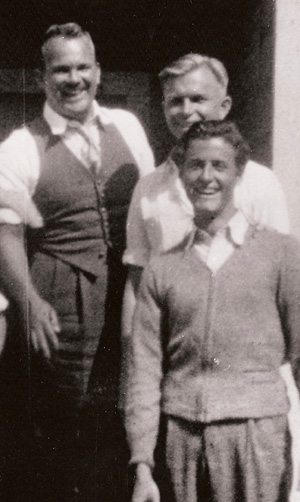Indiana Jones and the Kingdom of the Crystal Skull (Steven Spielberg, 2008)
Man, this is some bad movie.
And keep in mind; this is from someone who managed to enjoy some of the Star Wars prequels.
Indiana Jones and the Kingdom of the Crystal Skull (Steven Spielberg, 2008)
Man, this is some bad movie.
And keep in mind; this is from someone who managed to enjoy some of the Star Wars prequels.
Indiana Jones and the Temple of Doom (Steven Spielberg, 1984)
In the lead-up to the release of Indiana Jones and the Kingdom of the Crystal Skull, a longstanding argument was revived. Which is the second best Indiana Jones film: Indiana Jones and the Temple of Doom, or Indiana Jones and the Last Crusade? The two films split fans of the series down the middle; they are so different, and the qualities people value in each are so different, that there is no room for agreement. (It’s one of those arguments where both sides are surprised that the other could even pose such a question.) About the only thing that unites everyone is the unstated assumption that, of course, Raiders of the Lost Ark is the untouchable, streets-ahead best of the series. I, too, love that film: I can’t fault so much as a single shot, line-reading, or camera angle. It’s funny and exciting. Harrison Ford is awesome as Indiana Jones, and the supporting cast are all fantastic. A number of sequences – the flying wing fight, in particular – are amongst the most skilfully mounted in Spielberg’s extraordinary oeuvre. But here’s my dirty little secret… as time has gone by, I think I have come to love Indiana Jones and the Temple of Doom even more than Raiders.
Citizen Spielberg, (Lester D. Friedman, University of Illinois Press, 2006)
Empire of Dreams: The Science Fiction and Fantasy Films of Steven Spielberg (Andrew M. Gordon, Rowman and Littlefield, 2007)
DAVID ST HUBBINS [Michael McKean]: It’s such a fine line between stupid, and…
DEREK SMALLS [Harry Shearer]: … and clever.
– This Is Spinal Tap (Rob Reiner, 1984)
Two familiar devices are used to frame the discussion of Steven Spielberg’s films in Lester D. Friedman’s Citizen Spielberg and Andrew M. Gordon’s Empire of Dreams. The first is the mandatory apology: the slightly defensive opening where the author justifies their interest in such a populist and ubiquitous filmmaker. One would hope such protestations are no longer needed, but I suspect Friedman has not exaggerated the snobbishly dismissive reactions of many colleagues when he told them the subject of his book. Dropping Spielberg’s name with any enthusiasm into a film-related discussion is still a faux pas worthy of the same sort of awkward silence that might follow a fart at a dinner party; we should not be harsh on authors for offering such an apologetic opening while these attitudes prevail.1 The second familiar introductory refrain is that the existing work on the subject is patchy or misguided, allowing the present author to sweep in and produce a definitive account. With regards to coverage, the case is hard to make; Spielberg’s work has been the subject of a number of book length studies already.2 While these, of course, have their own quirks and flaws, collectively they amount to a substantial body of critical work, and it is hard to sustain an argument that Spielberg’s work is under-discussed. Gordon’s approach is to differentiate his book by concentrating on a niche of Spielberg’s filmography (albeit a large niche that covers much of his output) – science fiction and fantasy films; while Friedman distinguishes his book from the others which he categorises as either biography, interviews, behind-the-scenes accounts or “general commentaries for fans” (p.1). However, I’m not sure that such categorical nit-picking can really sustain Friedman’s contention that scholars have “ignored” Spielberg (p.1). What is perhaps more accurate – and this brings us back to the point about snobbery – is that the vast amount of critical and academic work on Spielberg has failed to substantially shift opinions of his basic merits as a filmmaker. Peter Biskind’s Spielberg-and-Lucas-destroyed-Hollywood narrative is still all-too widespread.3, and there remains a tendency to fixate on certain aspects of his style (like characters gaping up at bright lights) that are perhaps more appropriate to a study of his work circa 1983. I have little doubt that Spielberg’s reputation will rise over time, as a generation of critics and theorists who have grown up with Spielberg and have an ingrained sympathy towards him come to the fore.4 For now, though, there is enough orthodoxy in the approach to Spielberg that Friedman and Gordon can cast themselves as iconoclasts for offering even a limited defence of him.
A really interesting bit of animation history appeared over at Thad Komorowski’s blog: the infamous “Jones-Avery letter.” It is an open letter written by Chuck Jones (and annotated by Tex Avery) angrily denouncing Clampett’s attempts to “claim” the history of Warner Bros. cartoons. Michael Barrier adds his commentary from an old essay on the letter here; the letter also provides interesting background to this essay by Milton Gray here.

It’s one of the great stories of animation: the three best directors at Warner Bros., and I think arguably the three greatest figures – outside of Disney – of animation’s Golden Age, start as collaborators and finish in their twilight years bickering over their legacy. Jones, in particular, would barely acknowledge Clampett’s existence when he talked about the studio.
I saw Iron Man the other day. I enjoyed it, but don’t have enough to say about it to warrant a full review. Suffice to say it reminded me a lot of the first Spider-man film; well-written, with good characters and performances and a healthy sense of conviction in the exercise by all involved, but at the same time lacking the really big show-stopping scenes that would have made it more memorable (the climax is really just two guys in metal suits punching each other.) It made me think of these comments by Paul Rameker in an article I’ve linked to before, over at David Bordwell’s page:
I have a theory. In the contemporary comic-book blockbuster, the sequels will always be better than the first entries. Spider-Man 2 is better than Spider-Man, X-Men 2 is better than X-Men, and I will bet that The Dark Knight will be better than Batman Begins, just as Batman Returns was better than Batman. The pattern seems to me to be that the first film in the series is relatively impersonal – the franchise must be established as a franchise, meaning that few boats will be rocked, and the director must prove that they can handle both a film on that scale, and can be trusted with the property with all the investment it represents.
But once they’ve done so, in the above cases where the first films enjoyed significant economic (and critical) success, the directors are given a bit more leeway, are allowed to drive the family car a little further and a little faster. In each case, the second film in the series by the same director has been significantly more idiosyncratic. Batman Returns has much more of Burton’s sense of humor and interest in the grotesque; X-Men 2 is a much more serious and ambitious film narratively and thematically, more obviously the product of a prestige filmmaker (Singer’s never been an auteur by any stretch, so that will have to do). Spider-Man seemed sort of anonymous in terms of style, but Spider-Man 2 had a much more extensive and playful use of classic Raimi techniques: short, fast zooms; canted angles; rapid camera movements; whimsical motivations for techniques, like the mechanical-tentacle POV shot (virtually a repeat of his flying-eyeball POV from Evil Dead 2).
I would second all that and also add that these days, the sequel will get more money spent on it than the original; this and the more straightforward stories allowed once the “origin” story is out of the way means the second film in a series can usually be more action-focused. (Yes, this is a good thing.) The old idea that sequels gradually fade away in terms of quality should be considered completely dead, at least as far as first sequels go; third films in series remain much dodgier propositions.
Because obviously I’m now officially part of the hype machine, here is the new trailer for Indiana Jones and the Kingdom of the Crystal Skull.
Apologies for the absence of material for the website lately; apart from the usual non-filmy stuff, I’ve been working on an article / review for Senses of Cinema which has kept me occupied. Hence the cluster of minor items today as I post a few tidbits I hadn’t had time to address.
One thing I wanted to point out, for the academicy / bloggery type people who read this site, is this article by Kristin Thompson that reaffirms her longstanding argument in favour of the legality of using film stills – rather than publicity stills – in support of film criticism. I’ve relied on her reasoning for a long time, and it still seems sound to me. I just point this out because I still see a lot of books and websites still illustrated primarily with publicity stills (indeed, both the books I talked about in my SOS article rely largely on such stills). I’ve never had any interest in using such stills: I’d rather rely on images that actually come from the movie itself to illustrate my points.
For popular review type websites, use of publicity stills is usually harmless enough, but in the case of academic books, it’s another subtle factor that seems to encourage authors not to worry about close analysis of what is actually on screen (the primary factor in this remains laziness). So I just thought that Thompson’s article was worth a nod. Vive La Film Still!

Plans to reform the parking controls in the Planning Scheme have been thrown into disarray following the extension of the heritage controls to cover Clause 52.06 of Victorian Planning Schemes.
The heritage protection comes after the objectives of the heritage overlay were extended to cover issues of natural, cultural, architectural, social and bureaucratic significance. It represents a win for proponents of the emerging field of administrative heritage.